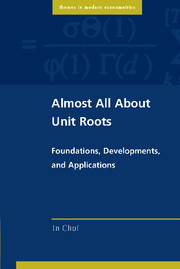Book contents
- Frontmatter
- Dedication
- Contents
- Foreword
- Preface
- Abbreviations and Notation
- 1 Introduction
- 2 Inference on Unit Roots: Basic Methods
- 3 Unit Root Tests under Various Model Specifications
- 4 Alternative Approaches to Inference on Unit Roots
- 5 Other Issues Related to Unit Roots
- 6 Seasonal Unit Roots
- 7 Panel Unit Roots
- Epilogue
- References
- Index
4 - Alternative Approaches to Inference on Unit Roots
Published online by Cambridge University Press: 05 May 2015
- Frontmatter
- Dedication
- Contents
- Foreword
- Preface
- Abbreviations and Notation
- 1 Introduction
- 2 Inference on Unit Roots: Basic Methods
- 3 Unit Root Tests under Various Model Specifications
- 4 Alternative Approaches to Inference on Unit Roots
- 5 Other Issues Related to Unit Roots
- 6 Seasonal Unit Roots
- 7 Panel Unit Roots
- Epilogue
- References
- Index
Summary
Introduction
Inferential procedures in the previous chapters use mostly OLS or MLE along with asymptotic critical values, take the alternative hypothesis as stationary AR processes, and have a unit root as their null hypothesis. They also belong to the class of classical statistical procedures that treat parameters as unknown constants. But there are many other approaches to inference on a unit root that do not necessarily share these features. This chapter introduces those alternative approaches to inference on a unit root.
This chapter deals with the following topics. First, unit root tests that take the alternative hypothesis as fractionally integrated processes are introduced. Unlike most unit root tests in this book that embed their null and alternative hypotheses in the AR model, these tests use fractionally integrated models. They also have standard distributions in the limit unlike other types of unit root tests. Second, this chapter introduces regression methods for the AR model that are robust to outliers. These methods are based on different asymptotic theory from OLS and are technically more involved than OLS. Third, model-free tests for a unit root are introduced. These tests are less model dependent, and some are robust to outliers and useful in this sense. Fourth, bootstrapping methods are discussed in relation to the inference on a unit root. Bootstrapping methods are known to be useful to find finite-sample critical values for hypothesis testing and to construct more accurate confidence intervals. How bootstrapping works for the AR model with a unit root is explained. Fifth, Bayesian inferential methods for a unit root are surveyed. These methods sometimes yield empirical results different from those using the classical approach and hence have attracted much attention. They have also evoked vigorous and stimulating methodological debates among Bayesians and non-Bayesians. Sixth, tests that take stationarity with or without structural changes as the null hypothesis are introduced. Some of these tests are used quite often in practice to complement unit root test results.
- Type
- Chapter
- Information
- Almost All about Unit RootsFoundations, Developments, and Applications, pp. 88 - 136Publisher: Cambridge University PressPrint publication year: 2015



